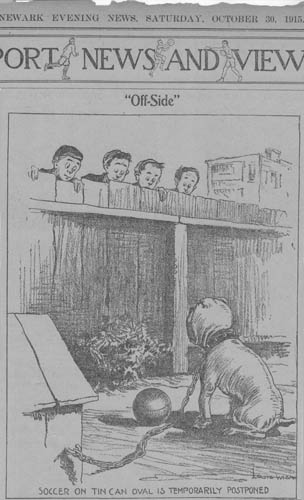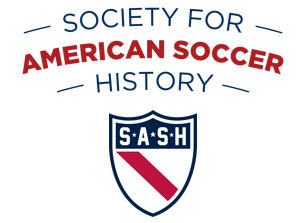
Manny Schellscheidt likes to keep the game simple. He recalls setting up countless pickup games over the years, saying, “We divide the kids up, whatever the numbers, play to five goals, and sometimes put ‘conditions’ on them like two-touch. They can remember the rules and just keep going. It’s the game that never ends.”
The 74-year-old Schellscheidt, who coached Seton Hall University until recently, hosts a pickup game each Thursday at a small, dusty gymnasium near his home. The rules are simple: he picks the teams, he keeps track of each 5-minute game on his decades-old Timex watch, and the ball never goes out of bounds. There are some unwritten rules, though. Manny stacks his team with the best players, you don’t tackle the ball away from him, and you laugh at his jokes.
Manny’s game is nearly 40 years old, and like pickup games all over this country, it has its own rules, code of conduct, and culture. In fact, it serves as a metaphor for the very nature of pickup soccer as there are games everywhere, day after day, week after week, and year after year. Pickup soccer is really the game that never ends.
Gwendolyn Oxenham’s recent essay on the history of pickup soccer in the United States contradicts this reality. She writes: “Maybe every American fan believes we have no story to tell—no equivalent history. That our version of the game is missing the romance, the folklore, the streets filled with barefoot 5-year-olds. Our players grew up with carpools and club practices, which don’t quite have the same ring.”
Oxenham has the “street cred,” or at least the pickup cred, to make such a statement. She and three companions made a documentary about their search for pickup games in 25 countries, but I could easily find 25 different games within 25 minutes of my New Jersey home, each with a different story, each with a different history.
Those games range from the one across the street as my 8-year-old neighbor constantly plays with his buddies in front of a Kwik Goal rebounder to the one at the park a few blocks away where Latino men play on Sunday mornings. The county park commission turfed a nearby dust bowl a few years ago, and that field is in constant use, so much so the county had to re-turf a portion of it. They play from sideline to sideline, sometimes 11 versus 11, and try to score on large orange cones, no doubt “borrowed” from the local utility company.
The oldest continuous pickup game I know of is the one at The Courts in Harrison, a 10-minute walk from Red Bull Arena. In 1963, some Harrison High boys commandeered two tennis courts and claimed them for soccer. They rolled up the tennis nets, pulled up the net posts and started playing small-sided games on the smooth black asphalt. Town officials put the nets back up, only for the boys to cut them down again. Generations of players—including former U.S. National team stalwarts John Harkes, Tony Meola, and Tab Ramos—have battled each other in epic six-a-side, winner-stays-on, losers-go-to-the-back-of-the-line pick-up games ever since. In 2006, Harrison fire chief, Tom Dolaghan, told The New York Times, “This is the incubator.”
Neighboring Kearny, dubbed Soccertown U.S.A. during the 1990 World Cup because three Kearny boys played for the U.S. squad, has its games, too. At recess, school children play pickup, which is made easy because school officials paint soccer lines on blacktops. Here, soccer trumps four square and touch football. After school and on weekends, kids ride their bikes to Harvey Field in order to play.
“It’s not like The Courts where the pickup game was in one spot,” noted Gerald Munro, vice president of Thistle FC, one of the youth soccer clubs in town. “I don’t think you’ll ever get that again because it’s more spread out now. There’s a lot more pickup soccer going on now.”
The most intriguing soccer field is a small one tucked in between an old thread mill and the East Newark town hall. Some 60 yards long by 30 yards wide it is also turfed, and for romantic reasons I like to think that the first sandlot soccer was played there. A mere 0.123 square miles, East Newark was home to Clark Thread Company, a mass producer of spool cotton and great soccer teams. Clark Thread sponsored the first American soccer dynasty as the company team won three consecutive American Football Association cups between 1885 and 1887. The company also built the first corporately sponsored soccer field in the country across the street from the mill. That field is now paved over, and it serves as a parking lot for a typical Jersey diner.
But the tiny East Newark field still exists, and maybe in its former life it was what local boys called “Tin Can Oval.” A series of illustrations captured life there in 1915, and it’s a cross between “The Little Rascals” and “Sandlot.” One cartoon entitled “Off-Side” depicts the boys peering over a fence at their ball next to a giant bulldog. The caption reads, “Soccer on Tin Can Oval is temporarily postponed.” A second one has another neighborhood dog heading home “the winning goal.”
Pickup soccer comes in all shapes and sizes. What is your pickup game like? What about its rules, code, culture, and history?
It’s the game that never ends.
A version of this article originally appeared on the New York Times Goal Blog.

Pingback: Yankee, Cowboy, Fenian Bastard: An American Catholic at Rangers Football Club | Society for American Soccer History
Pingback: Yankee, Cowboy, Fenian Bastard: An American Catholic at Rangers Football Club – Society for American Soccer History